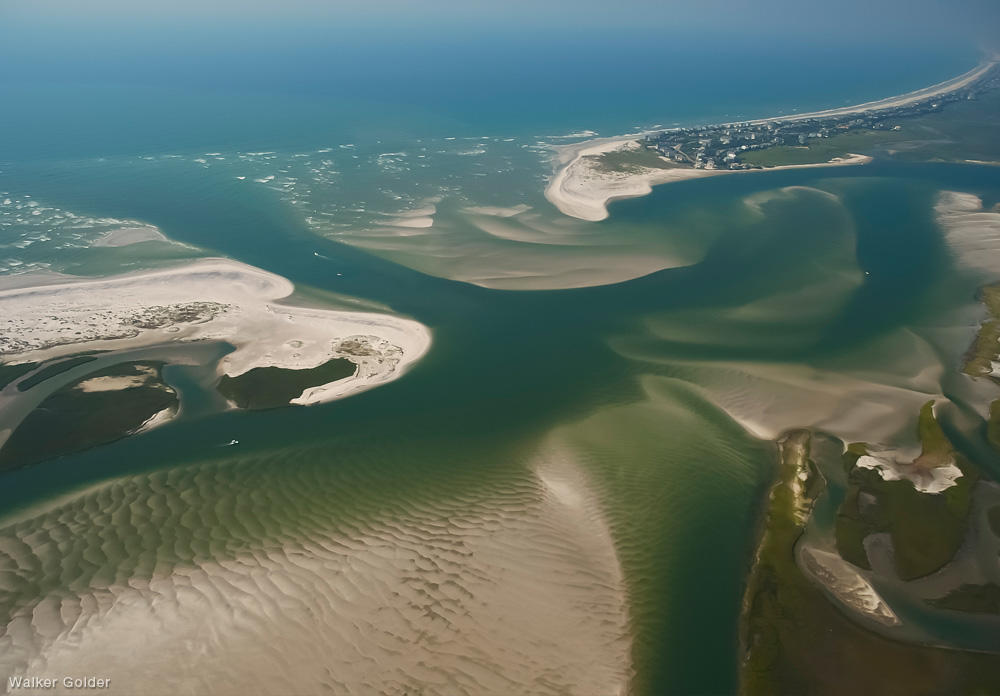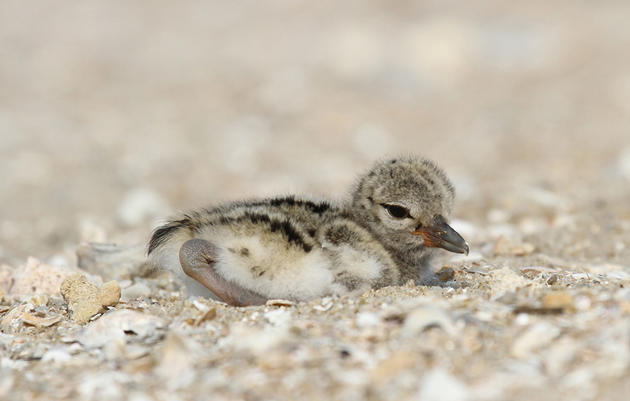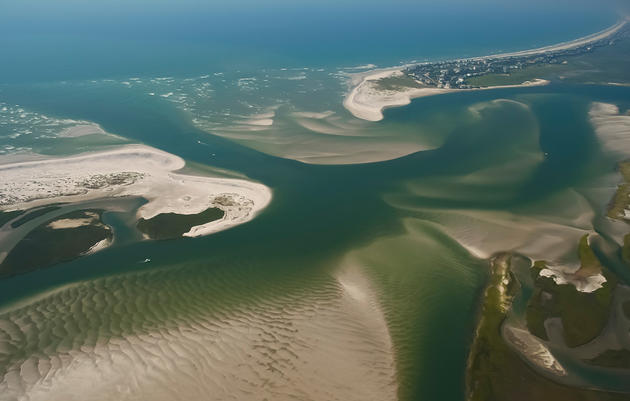The North Carolina coast is bordered by narrow ribbons of sand called barrier islands. These sinuous, sandy islands stretch from Corolla to Sunset Beach fronting the mainland. Where two barrier islands meet, you’ll find an inlet: a waterway that connects the ocean with the sound.
Inlets provide essential habitat for many species including:
- Expansive tidal flats rich with food that wintering and migrating shorebirds need to survive;
- Sandy spits that serve as roosting sites where shorebirds can rest, digest and conserve energy;
- and open or sparsely vegetated areas where beach-nesting birds raise their young.
Noted shorebird biologist Brian Harrington coined the term “inletophilic” to describe shorebird species that not only use, but also require inlets for their survival. He analyzed shorebird distribution and abundance at 361 sites in the southeastern U.S. over many years and found that the lives of seven shorebird species are tied to inlets including the Piping Plover, Red Knot, Western Sandpiper and Wilson’s Plover.
Why Rich Inlet is Special to Shorebirds
One of the best inlets in North Carolina for shorebirds is Rich Inlet, located in Pender County between Figure 8 Island to the south and undeveloped Lea-Hutaff Island to the north. View Rich Inlet from above and you can see its vast flats and sandbars, as well as extensive sandy spits on both sides of the inlet.

These features are typical of large, natural inlets, and they have attracted 90 species of birds to Rich Inlet.
Audubon North Carolina has been monitoring how birds use Rich Inlet since 2007. Through regular surveys, we have documented its year-round importance to birds.
Piping Plover: Threatened and endangered Piping Plovers depend on Rich Inlet during migration and winter. More than 20 individuals from the Great Lakes population, which consisted of just 73 breeding pairs in 2015, have been seen at Rich Inlet during our study period.
Red Knot: Federally threatened Red Knots also use Rich Inlet. During spring migration they refuel during their long journey to breeding grounds in the Arctic. From bands, we know that some have come to Rich Inlet from wintering grounds in southern Argentina.
Arctic Breeders: Thousands of Arctic-breeding shorebirds like Dunlin, Sanderlings, Short-billed Dowitchers, Western and Semipalmated Sandpipers, and Black-bellied Plovers are abundant.
Rich Inlet also supports large numbers of nesting birds. In 2014, more than 800 pairs of Least Terns nested on the large, sandy spit located on the north end of Figure 8 Island, along with American Oystercatchers, Common Terns, Black Skimmers, Piping Plovers, Wilson’s Plovers and Willets. It was the largest colony of Least Terns in North Carolina in more than 40 years and one of the largest on the entire Atlantic coast. In 2015, Rich Inlet again hosted the largest Least Tern colony in the state.
Threats to Rich Inlet
Of the twenty inlets in North Carolina, Rich is one of the few natural inlets left in the state. It is also one of the most stable inlets in the state and has remained in the same general location for the past 100 years.
So far, Rich Inlet has escaped hard structures like jetties and terminal groins that drastically alter inlets and destroy habitats that birds require. Terminal groins and jetties disrupt natural sand transport in, around, and past inlets, starving them of sand needed to maintain intertidal flats and shoals that birds need for foraging and roosting and increasing beach-front erosion down-current.
Unfortunately, Rich Inlet is now threatened by a proposal to build a $26-million terminal groin at the north end of Figure 8 Island. Its supporters say the proposed groin would protect houses on the north end of the island. However, these statements don’t hold water:
- Natural accretion around Rich Inlet has widened the beach so that currently no houses are in danger.
- The terminal groin would increase beachfront erosion down-current from it, threatening scores of houses to its south.
- There are other less expensive and less environmentally destructive methods to protect houses, should any be threatened again in the future.
- The terminal groin would permanently remove the habitats that nesting, migrating and wintering birds need to survive. Affected species include threatened and endangered Piping Plovers, whose migratory stopover and wintering areas are already degraded by coastal development elsewhere.
Audubon North Carolina, along with the North Carolina Coastal Federation, the Southern Environmental Law Center, and local conservation groups, is working to save Rich Inlet. If a terminal groin were to be constructed at Rich Inlet, critical bird habitat will be lost. This would deprive the thousands of birds using Rich Inlet of the habitat they need for survival—and deprive humans of Rich Inlet’s incredible natural spectacle.
To receive updates on how you can help protect fragile coastal habitats like Rich Inlet, sign up for our advocacy alerts here.









